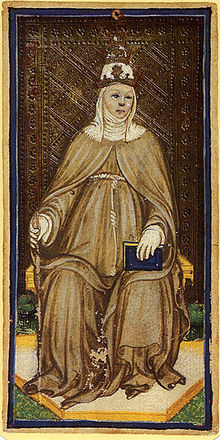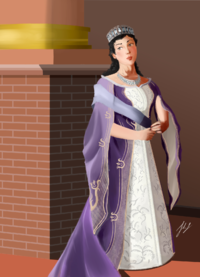Katerina Cardinal Jorenus
|
| |||||||||||||||||||||||||||||||||||||||||||||||||||||
Contents
Introduction
Katerina Cardinal Jorenus, born Katerina Ceciliya Barbanov-Bihar, was the second female Cardinal of the Church of the Canon, additionally serving in positions such as Pontifical Chamberlain, Matriarch of Jorenus, and Bishop of Valwyck. Her early life was mired in trauma and chaos at the hands of her brother, King Henrik II, which she only managed to escape once High Pontiff Everard VI allowed female priesthood. She was elevated to the rank of Bishop, overseeing the Diocese of Valwyck, during Tylos II, and she spent most of her time here amongst the Ayrikiv commoners in Lollybroch. Upon Tylos III’s ascension as High Pontiff, she succeeded him to the Patriarchate of Jorenus, thus becoming the first Matriarch.
Early Life as a Princess & Military Career
Katerina’s early childhood was similar to many Princesses’ lives. She was tutored by her mother, Queen Isabel, and the many governesses, and was pampered by them, as well as isolated from the real world, safe within the confines of the Nikirala. Her youth was primarily spent among her close friends, namely Mariya of Aurveldt, Stefan Vyronov, Marie Barclay, and Camilla vas Ruthern. She had, until now, had a comfortable childhood, as well as a close bond with her father, Josef I. However, when her father passed, the chaotic period of her youth began. Tainted by the Crown, Katerina’s alleged abuse from her older brother; accusations became solidified when she fled the Kingdom for a period. Once she was found and escorted back, they stripped her of her titles, Princess Royal and Baroness of Antioch.
|
A portrait of then Princess Royal, Katerina Ceciliya during her Hauchmetvas, 1808 |
She enlisted in the BSK as a teenager, discovering that she was a naturally prodigal medic and a career she pursued closely from then on. Her efforts during the Rimetroll War proved to be tremendous, as many lives were directly saved by her hand. Of particular note was her leadership of an expedition to the home of the Rimetrolls, as a group of Haeseni, who had been attempting to broker peace with the Rimetrolls, had been buried under ice and snow due to the intervention of hostile mages. The expedition was a success, and all lives were saved as a result. Though most famously, she managed the killing blow on a so-called Rock Troll, which earned her the nickname Rocktrollsbane from Lord Marshal Friedrich Barclay. After the conclusion of the war, she was appointed Surgeon-General, but would perhaps ironically spend most of this period suffering from mental health issues.
Leaving Haense
In 1838, due to the trauma of both her brother’s abuse and the Rimetroll War, she resigned from her position of Surgeon-General and the BSK. Deciding it was time for a change, she packed her bags and left, only informing a few close companions at the time as she had yet to decide on where to go. Eventually, she ended up settling in Oren, where she discovered that her best friend, Mariya, had feigned her death, and now went by the name of Anna while residing there. The two quickly reconciled their friendship and grew close once more, as they were a great comfort to one another during her time in Oren.
Once it was discovered she had settled in Oren, she was stripped of her Princess titles in Haense, though she was not disowned from the House of Barbanov-Bihar. During her stay in Oren, she began teaching medicine again to field medics and practising medicine herself in the Orenian army.
The Call to Clerical Garments
High Pontiff Everard VI decreed women were allowed to become priests in the year of 1849. Katerina had always held her religion close to get her past her troubling life and so she felt that this was a sign from God himself that this was her path in life. She became an acolyte of the Church of the Canon and wrote her first thesis on St. Julia. which was accepted and she was then ordained by Patriarch Jordan alongside Presbyter Ilyana as the first priests that were women in the year of 1850.
After her ordination, her work began in Karosgrad, and she created the Monastic Order of Bl. Nicolas, which was later rebranded into the Holy Order of St. Nicolas the Martyr. Her group went around Almaris and protected fellow clergy members and guarding them when needed during the War of the Wigs, they also slayed unnatural beings they deemed threatening. Though when she was elevated to the rank of Bishop, her work in the order became more absent due to her new responsibilities. She held masses and confessions to calm citizens during the war and comforted those who needed it.
After the war, Katerina continued her duties as Bishop of Valwyck. She also began the planning for a Remembrance Day for those who had recently died. Remembering the people who gave their lives during the war and those that had died during peacetime. She and a group of Haeseni citizens went to all the lands of Hanseti-Ruska to place flowers on all the graves and crypts. Which later gave her the idea for the funeral planning of High Pontiff Tylos II, which she called The Walk of the Pontiff.
The Walk of the Pontiff started in Freimark, where Tylos II was assumed to be from. She and a large group of people placed down white Chrysanthemum flowers in front of the church and gave a few words of appreciation and respect. Then their path took them to the ruins of Savoy where they paid their respect as well. They continued to Balian, then to Haense and at last to Oren. Laying the flowers in front of every church along with some words of appreciation and respect. The group then walked to the barony of Grodno, where Katerina performed the funeral ceremony before finally laying His Holiness to rest.
Matriarch of Jorenus
After Tylos III had been elected as High Pontiff he asked Katerina if he could speak to her. He then revealed his intent to make her the new Matriarch of Jorenus and the Pontifical Chamberlain. She graciously accepted and in his first bull, the year of 1877, it was made public of her elevation in the Church of the Canon. Making her the second Cardinal that was a woman. She was also the first Matriarch of Jorenus and the first Pontifical Chamberlain that was a woman in Church history. After Katerina had been made a Cardinal the people then saw her wear her new beautiful red robes with the coat of arms of Jorenus on her shawl that she had sewn and embroidered herself just for this new position.
Her first work as a Cardinal was to host a children’s pilgrimage for the children of Hanseti-Ruska which led into the lands of Kharasi Oasis during the Almaris Coalition War. By the blessing of God, they were kept safe and no bandits harmed them or stopped them during this walk. Along with this, she was often seen walking around the city, speaking to those in the tavern and being welcoming to noble and commoner alike. Her first official and grand event was however the Church Gala that was hosted in Haense in the year 1822. Which gathered a large sum of money into the Church Treasury from the Raffle hosted by the Matriarch.
She continued her duty to the Church and her people by taking in many wards and training them personally into priests during all of Tylos III’s reign as pontiff until his death. A new pontiff was elected by the curia and she continued to serve as the Cardinal of Jorenus and Pontificial Chamberlain under the new pontiff, Pontian IV. She began to plan out the second Church Gala that was to be hosted in Balian at the start of his reign. Which ended up with great success and was enjoyed by all the faithful. She had planned to hold one in the Kingdom of Oren as well, but such plans fell through when the kingdom collapsed.
Katerina was often the first one to speak up against war whenever such ideas came up, which garnered some dislike from her great nephew, Karl III, the King of Haense at the time. Though she was met with an understanding of her reasons, the two quickly reconciled and grew closer along with the rest of her family. This allowed her to stand beside him in many diplomatic meetings. The most memorable one being the Summit of Karosgrad between Haense, Balian, Petra and Aaun, as a cherovsky knight attempted to attack Karl III. Katerina however took the hit from the man’s sword as the woman stepped in front of the two. The knight was quickly killed afterwards, though leaving her heavily wounded and then treated by the medic Euleriphis Melphestaus. But it was an attack she survived and was celebrated for saving the King many years afterwards.
She continued her work as a Cardinal after the attack and hosted a few masses, weddings and funerals for as long as her health allowed her to. Her last official event was the Coronation of the King and Queen of Hanseti-Ruska Georg I and Esfir of Jerovitz in the year of 1908. During this, it had been said the Matriarch had been high on pain medication to get through it. Katerina had not been spotted out in public since, and on the 4th of the Sun’s Smile in 1910 she had been pronounced dead due to old age. Having lived a total of 116 years. She was after her death venerated in the twentieth Golden Bull of Jorenus in the year of 1912 for diligent service to the Mother Church for sixty years. Remembered well for being the first Matriarch of Jorenus and the second female Cardinal of the Church.


